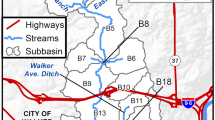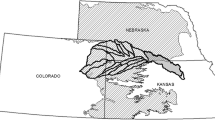Abstract
Current research in real-time water simulation can also calculate hydraulic erosion to a landscape; however, vegetation, which carries one of the biggest impacts on hydraulic erosion, is often not considered. We proposed an improvement upon the virtual pipes model for real-time hydraulic and thermal erosion simulation by incorporating considerations for vegetation cover. This method advances previous work by considering the limiting of soil erosion in vegetated areas due to soil binding, leaf cover, and transpiration from the plants. It also considers the impacts of vegetation death and the erosion and transportation of dead vegetation matter. Our algorithm creates a more realistic real-time erosion simulation, as seen by comparing erosion results with and without considering vegetation. Our results run in real time and clearly show the erosion effects expected by combining these methods.






Similar content being viewed by others
Explore related subjects
Discover the latest articles and news from researchers in related subjects, suggested using machine learning.References
Al-Hashemi, H.M.B., Al-Amoudi, O.S.B.: A review on the angle of repose of granular materials. Powder Technol. 330, 397–417 (2018)
Alejandro, M., Omasa, K.: Estimation of vegetation parameter for modeling soil erosion using linear spectral mixture analysis of landsat etm data. ISPRS J. Photogram. Remote Sens. 62(4), 309–324 (2007)
Andersson, J.: Terrain rendering in frostbite using procedural shader splatting. In: SIGGRAPH 2007 Courses, pp. 38–58 (2007)
Beneš, B.: Real-time erosion using shallow water simulation. In: Workshop in Virtual Reality Interactions and Physical Simulation. Eurographics (2007). https://doi.org/10.2312/PE/vriphys/vriphys07/043-050
Beneš, B., Těšínskỳ, V., Hornyš, J., Bhatia, S.K.: Hydraulic erosion. Comput. Anim. Virtual Worlds 17(2), 99–108 (2006)
Borgeat, L., Massicotte, P., Poirier, G., Godin, G.: Layered surface fluid simulation for surgical training. In: International Conference on Medical Image Computing and Computer-Assisted Intervention, pp. 323–330. Springer (2011)
Butt, M.J., Waqas, A., Mahmood, R.: The combined effect of vegetation and soil erosion in the water resource management. Water Resour. Manag. 24(13), 3701–3714 (2010)
Casulli, V.: Semi-implicit finite difference methods for the two-dimensional shallow water equations. J. Comput. Phys. 86(1), 56–74 (1990)
Chorin, A.J., Marsden, J.E., Marsden, J.E.: A mathematical introduction to fluid mechanics, vol. 175. Springer, Berlin (1990)
Cordonnier, G., Galin, E., Gain, J., Benes, B., Guérin, E., Peytavie, A., Cani, M.P.: Authoring landscapes by combining ecosystem and terrain erosion simulation. ACM Trans. Graph. (TOG) 36(4), 1–12 (2017)
Crespin, B., Bézin, R., Skapin, X., Terraz, O., Meseure, P.: Generalized maps for erosion and sedimentation simulation. Comput. Graph. 45, 1–16 (2014)
Dagenais, F., Guzman, J., Vervondel, V., Hay, A., Delorme, S., Mould, D., Paquette, E.: Real-time virtual pipes simulation and modeling for small-scale shallow water. In: Workshop in Virtual Reality Interactions and Physical Simulations, pp. 45–54 (2018)
Galin, E., Guérin, E., Peytavie, A., Cordonnier, G., Cani, M.P., Benes, B., Gain, J.: A review of digital terrain modeling. In: Computer Graphics Forum, vol. 38, pp. 553–577. Wiley Online Library (2019)
Gingold, R.A., Monaghan, J.J.: Smoothed particle hydrodynamics: theory and application to non-spherical stars. Month. Notices R. Astron. Soc. 181(3), 375–389 (1977)
Jákó, B., Tóth, B.: Fast hydraulic and thermal erosion on gpu. In: Eurographics (Short Papers), pp. 57–60 (2011)
Kellomäki, T.: Interaction with dynamic large bodies in efficient, real-time water simulation. J. World Soc. Comput. Graph (2013)
Kellomäki, T.: Rigid body interaction for large-scale real-time water simulation. Int. J. Comput. Games Technol (2014)
Kellomäki, T.: Fast water simulation methods for games. CIE 16(1), 1–14 (2017)
Mei, X., Decaudin, P., Hu, B.G.: Fast hydraulic erosion simulation and visualization on gpu. In: 15th Pacific Conference on Computer Graphics and Applications (PG’07), pp. 47–56. IEEE (2007)
Mould, D., Yang, Y.H.: Modeling water for computer graphics. Comput. Graph. 21(6), 801–814 (1997)
Musgrave, F.K., Kolb, C.E., Mace, R.S.: The synthesis and rendering of eroded fractal terrains. ACM Siggraph Comput. Graph. 23(3), 41–50 (1989)
O’Brien, J.F., Hodgins, J.K.: Dynamic simulation of splashing fluids. In: Proceedings Computer Animation, pp. 198–205 (1995)
Renard, K.G., Foster, G.R., Weesies, G.A., Porter, J.P.: Rusle: Revised universal soil loss equation. J. Soil Water Conserv. 46(1), 30–33 (1991)
Stam, J.: Stable fluids. In: Proceedings of the 26th Annual Conference on Computer Graphics and Interactive Techniques, pp. 121–128 (1999)
Št’ava, O., Beneš, B., Brisbin, M., Křivánek, J.: Interactive terrain modeling using hydraulic erosion. In: Proceedings of the 2008 ACM SIGGRAPH/Eurographics Symposium on Computer Animation, pp. 201–210. Eurographics Association (2008)
Tasseff, B., Bent, R., Van Hentenryck, P.: Optimal flood mitigation over flood propagation approximations. In: International Conference on AI and OR Techniques in Constraint Programming for Combinatorial Optimization Problems, pp. 358–373. Springer (2016)
Tasseff, B., Bent, R., Van Hentenryck, P.: Optimization of structural flood mitigation strategies. Water Resour. Res. 55(2), 1490–1509 (2019)
Wischmeier, W.H., Smith, D.D.: Predicting rainfall erosion losses: a guide to conservation planning. 537. Department of Agriculture, Science and Education Administration (1978)
Acknowledgements
This research was partially funded by the NSF 1718139.
Author information
Authors and Affiliations
Corresponding author
Additional information
Publisher's Note
Springer Nature remains neutral with regard to jurisdictional claims in published maps and institutional affiliations.
Appendix
Appendix
Due to differences in soil types, vegetation types, weather, etc., there are a number of variables that can be adjusted either artistically to create the desired look in a simulation or to match the expected behavior in a real location. A list of the variables used throughout this manuscript can be found in Table 2.
Rights and permissions
About this article
Cite this article
Hawkins, B., Ricks, B. Improving virtual pipes model of hydraulic and thermal erosion with vegetation considerations. Vis Comput 39, 2835–2846 (2023). https://doi.org/10.1007/s00371-022-02496-0
Accepted:
Published:
Issue Date:
DOI: https://doi.org/10.1007/s00371-022-02496-0




